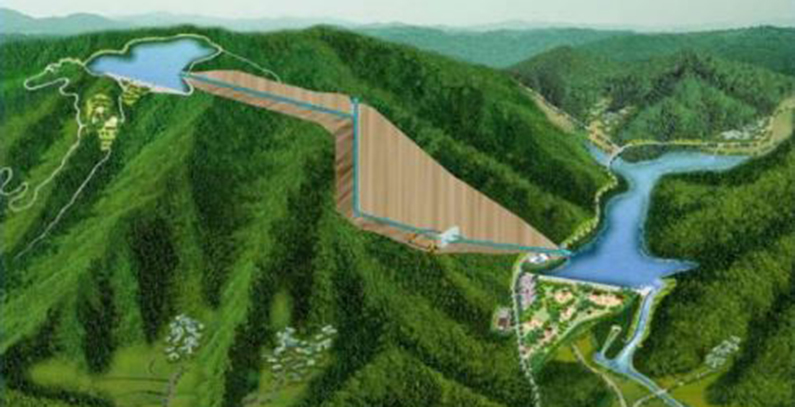Pump storage hydropower – PSH (pumped-storage hydroelectricity) or PHES (pumped hydroelectric energy storage) is a type of hydroelectric energy storage used for load balancing in electric power systems. Water pumped from a lower-elevation reservoir to a higher elevation is used to store energy in the form of gravitational potential energy. Pumps are often powered by low-cost surplus off-peak electric power. During times of high electricity demand, the stored water is released through turbines to generate electricity.
How Does Pumped Storage Hydropower Work?
A type of hydroelectric energy storage is pumped-storage hydropower (PSH). It’s a set-up with two water reservoirs at different elevations that can generate electricity (discharge) when water flows down through a turbine, which then draws electricity when it pumps water up to the higher reservoir (recharge).
PSH capabilities can be classified as an open-loop (where the reservoirs are connected to a natural body of water continuously) or a closed-loop (where the reservoirs are not connected to a natural body of water continuously).
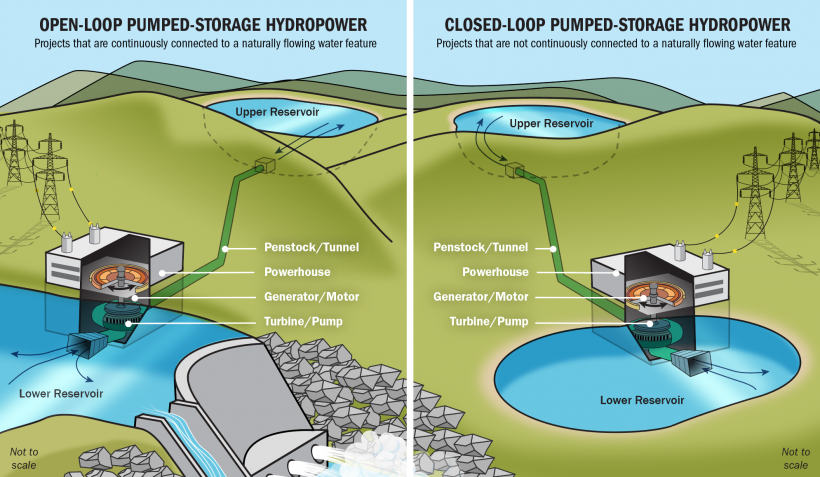
In the United States, pumped storage accounts for 95 percent of all utility-scale energy storage.
The Water Power Technologies Office (WPTO) of the US Department of Energy (DOE) invests in new pumped-storage technologies and research to better understand and quantify the potential advantages of existing and future advanced pumped-storage facilities. WPTO is actively putting together a research portfolio to assess and expand the contribution of hydropower and pumped storage to grid resiliency and dependability.
How Efficient Is Pumped Hydro Storage?
Pumped-storage hydroelectric facilities are large-scale energy storage systems that generate power using gravity. During low-cost energy seasons and high renewable energy generation periods, water is pushed to a higher elevation for storage. When electricity is required, water is returned to the bottom pool, where turbines generate power. Recent improvements have enabled PSH facilities to have variable speeds and work in closed-loop systems, allowing them to be more responsive to the demands of the energy grid. Unlike standard pumped-storage hydropower, a closed-loop PSH runs without being connected to a continuously flowing water supply, allowing pumped-storage hydropower to be used in more places.
Pumped-storage hydropower can be less expensive than other forms of energy storage, especially for very large capacity storage (which other technologies struggle to match). The cost of installing pumped-storage hydropower fluctuates between $1,700 and $5,100 per kW, according to the Electric Power Research Institute, compared to $2,500 to $3,900 per kW for lithium-ion batteries. During a full cycle, pumped-storage hydropower is more than 80% efficient, and PSH plants can typically generate 10 hours of electricity, compared to around 6 hours for lithium-ion batteries. Despite these benefits, PSH projects have the disadvantage of being long-term investments: permitting and construction can each take 3-5 years. This may deter investors who favor shorter-term investments, particularly in a volatile market.
The world’s largest pumped-hydro storage plant, located in Bath County, Virginia, provides power to around 750,000 residences. It was completed in 1985 and has a power output of about 3 GW.
Advantages and Disadvantages of a Pumped Storage Hydroelectric Power Station?
We drink it, swim in it, and rely on it for survival, but did you realize that water generates 16.6% of the world’s total electricity? There are millions of dams around the world, but just a few produce hydroelectric electricity to power our homes and businesses. While hydroelectric energy is a plentiful source of usable energy, it has both advantages and disadvantages. Take a look at some of the advantages and drawbacks of hydroelectric power.
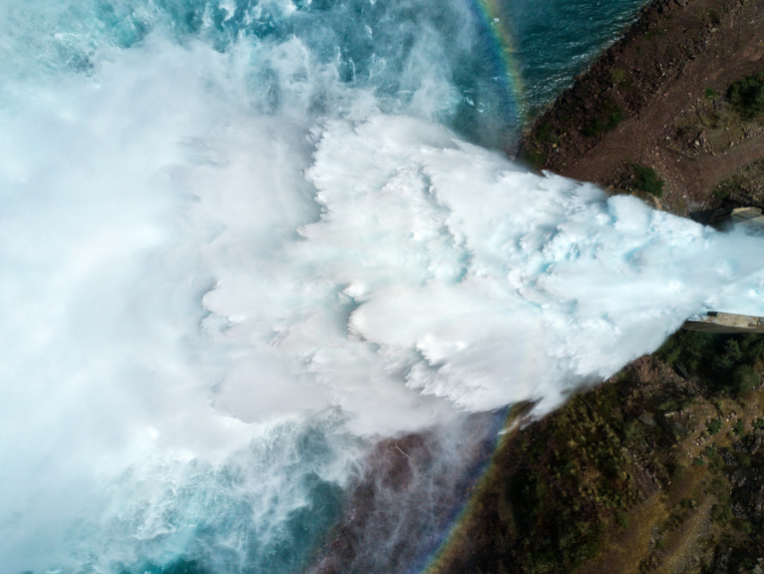
Pros of Hydroelectric Energy
Hydroelectric energy has numerous advantages, including renewable energy, zero emissions, and even recreational activities. Hydropower can even be a fascinating and entertaining subject to study. Take a look at some of the advantages of hydroelectric electricity in the following section.
It’s a Renewable Resource
While you won’t be drinking directly from a river (or the ocean) any time soon, one of the key benefits of hydro energy is that water is almost everywhere and can be utilized to generate electricity. Because of the water cycle, it is a non-depleting renewable resource, allowing us to save finite and non-renewable resources for other purposes.
Hydroelectric energy is also a valuable resource since it provides countries with more energy independence. Reduced demand for foreign fuel sources may help countries who struggle to receive gasoline from international sources minimize conflict and improve economic concerns. Instead, they can use hydro energy to generate clean, domestic power.
It’s Good for the Environment
Although it has significant drawbacks, hydroelectric energy is one of the most environmentally benign sources of energy production accessible today. It does not consume fossil fuels or emit hazardous emissions, and it also delivers a consistent supply of clean energy. So, what’s not to like about that? While dams can have a significant environmental impact, the only pollution they cause is during construction. There are no carbon emissions produced during the creation of energy.
It’s Reliable and Highly Efficient
One of the most significant advantages of hydroelectric energy is that it is one of the world’s most efficient energy sources. Consider that solar energy is only 30-36 percent efficient at best, wind energy is only 25-45 percent efficient at best, and coal power is only 33-40 percent efficient at best. All of these approaches pale in comparison to hydro energy, which converts water into electricity at a rate of up to 90% efficiency.
Because the flow of water is only interrupted for regular repairs, maintenance, and upgrades, hydroelectric energy has little to no downtime. Solar power, on the other hand, reduces production as the sun sets, while wind power is only useful if there is a constant breeze.
It’s Safe
Dams that create hydroelectricity have been relatively safe in comparison to many other forms of energy production over the years. The majority of the faults or problems that have arisen in older dams are the result of poor construction and low safety requirements. Another benefit of hydroelectric energy in these circumstances is that it does not require any combustible fuel, reducing the hazards associated with fossil fuels or nuclear energy.
It’s Flexible
Hydroelectric energy, unlike other kinds of energy such as solar, wind, or coal, is constant. The flow of water used to generate energy can readily be changed to meet demand. As a result, electricity can be made accessible just when it is required, reducing energy waste.
It’s Great for Recreational Use
Finally, dams usually result in the formation of reservoirs. If you live near a reservoir or have ever seen one, you know it’s a man-made lake where people go fishing, boating, swimming, windsurfing, and other activities. There are even some well-known reservoirs, such as Lake Mead, which was formed by the Hoover Dam.
Hydroelectric energy has numerous advantages, including energy independence and the ability to provide a long-term source of energy.
It’s Economical
Although the original cost can be high, the cost of upkeep and personnel compensation is comparatively inexpensive after a hydroelectric dam is up and operating. Plus, unlike traditional fossil fuels and imported fuels, the price of water does not fluctuate. Hydroelectric dams may save countries a lot of money, and certain countries, like Paraguay, can derive practically all of their electricity from them.
It’s a Fundamental Vehicle for Development
One of the benefits of hydroelectric electricity, aside from being a plentiful source of electricity, is that it is an effective and fundamental tool for the expansion of both new and established communities.
Hydroelectric power plants may accomplish this in several ways. For starters, they can provide a great amount of electricity to communities, even those that are far away. They can also provide motivation for highway construction, attract a variety of enterprises, and increase overall commerce. All of these advantages contribute to inhabitants’ overall quality of life when they use this form of energy.
Furthermore, hydroelectric energy promotes sustainable development, which means that it will not limit the ability of future generations to meet their unique demands.
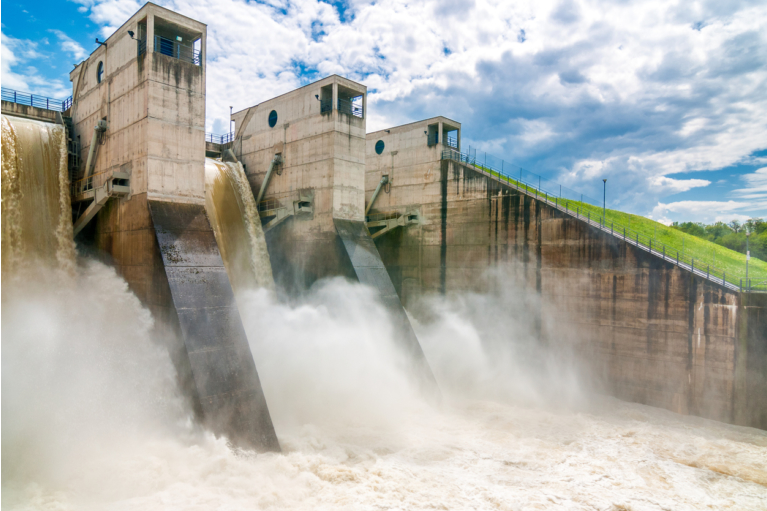
Cons of Hydroelectric Energy
The downsides of hydroelectric electricity are the polar opposite of all of these advantages. We must weigh the pros and cons of hydroelectric energy to understand the influence of our actions when developing sustainable energy solutions. Here are a few of the most notable drawbacks of hydroelectric power.
It Displaces People
Reservoirs not only push animals out of their natural habitats, but they also push people out. Hydroelectric energy’s disadvantages can have a significant influence on communities. People who have lived in an area their entire lives may be forced to relocate, and while they are usually compensated for their relocation, it does not recompense them for the losses they have suffered.
Dams have obliterated cities, towns, and villages, as well as displaced local cultures. When residents refuse to relocate due to development, they are occasionally evicted from their homes under threat of violence.
In one case, 369 Mayans were killed in Guatemala in 1982 after they refused to leave their homes to construct the Chixoy Dam. Dams have displaced millions of people throughout the years, forcing them to uproot their lives and families.
Building a hydropower facility also raises the risk of flooding at lower elevations. Those living in lower elevations may have their lives drastically affected, possibly permanently, if strong water currents are released from the dam.
It’s Expensive
Another downside of hydroelectric energy is the initial investment necessary to construct a dam. Despite their low operating costs, the time it takes for a dam to pay for itself varies greatly. Some dams take 2 to 5 years to build, while others take much longer, such as the Itaipu Dam in Brazil and Paraguay, resulting in higher expenses. The Itaipu Dam took 18 years and $18 billion to construct in all.
Dam construction cost an estimated $2,000 billion worldwide during the 1950s, with average construction delays of 44% and cost overestimates of 96%. Delays or overspending make it more difficult to recoup the money spent on the dam’s construction.
It Has an Environmental Impact
The environmental impact of hydroelectric energy is perhaps its most significant negative aspect. Dams have the potential to harm or otherwise disrupt the ecosystem both upstream and downstream during the construction process. To construct a dam, additional roads and electrical lines must be built, causing environmental disruption. Dams frequently create reservoirs, which flood enormous areas and dispense with natural habitats. When dams flood areas, they generate areas of still or stagnant water, which kills flora and causes it to decompose, emitting greenhouse gases. This is especially true in tropical and humid climates.
Fish migration can be severely hampered by dams, especially for species like salmon that rely on rivers to reproduce. Dams can even alter biological cues that inform fish where to migrate when it’s time. Some dams have attempted to address this hydroelectric energy disadvantage by constructing fish ladders or fish elevators to assist migratory fish in reaching their spawning areas.
Water quality is the final environmental drawback of hydroelectric energy on our list. Dams restrict the flow of water, which has an impact on the oxygen levels in the water. Decreased oxygen levels downstream can be a result of lower oxygen levels behind the dam. Some fish species have a harder time surviving when there is less oxygen in the water, which has an impact on river habitats.
A hydropower plant’s increased carbon dioxide and methane emissions can affect all types of aquatic plant life. Increased pollution from these greenhouse gases can cause plant life underneath the sea to decay, wreaking destruction on the ecology around it.
There are Limited Reservoirs
Even though water is an infinite resource, the conditions required to construct a dam are limited. This is a drawback of hydroelectric power because it means you can’t just build a dam wherever you want. Most of the appropriate places for hydroelectric dam construction have already been utilized. Another thing to consider is that even if a location is suitable for a hydroelectric dam, the project may not be profitable enough.
It’s Not Always Safe
Despite the lack of flammable fuel, dams pose their risks. Accidents on the job site, as well as a dam failure, can result in injury or death. During the building of the Hoover Dam, 112 people died, and one of the biggest disasters occurred when the Banqiao Reservoir Dam in China was demolished by a typhoon in 1975.
The Banqiao Dam’s subsequent failure resulted in the deaths of an estimated 171,000 people. Dams erected now, thankfully, are built to greater safety standards than those built in the past.
There are Droughts
It’s vital to consider the fact that water can and goes through cycles of abundance and drought when considering the benefits and drawbacks of hydroelectric energy. Lower-than-normal water levels can have a significant impact on energy production, which is a drawback of hydroelectric power.
Hydro energy production, in addition to being affected by drought, can also produce drought conditions downstream if it does not allow enough water to pass through. This is particularly problematic if the dam is built along a river or reservoir that permits water to flow into another country. Intentionally or unintentionally, the country upstream could trigger a drought in its adjacent country.
Potential Technologies
Underground Reservoirs
There has been researching into the usage of subsurface reservoirs. The planned Summit project in Norton, Ohio, the proposed Maysville project in Kentucky (underground limestone mine), and the proposed Mount Hope project in New Jersey, which intended to employ a former iron mine as the lower reservoir, are all recent instances. The proposed energy storage at the Callio site in Pyhäjärvi (Finland) would make use of Europe’s deepest base metal mine, with an elevation difference of 1,450 meters (4,760 feet).
There have been several new underground pumped storage projects planned. If existing underground mining space is used, cost-per-kilowatt estimates for these projects can be cheaper than for surface projects. There are few options for acceptable subterranean space, but if abandoned coal mines prove to be appropriate, the number of underground pumped storage options may expand.
Seawater
Seawater can be used in pumped storage plants; however, there are added obstacles when compared to freshwater. The 240 MW Rance tidal power station in France, which opened in 1966, can partially function as a pumped-storage facility. When high tides happen during off-peak hours, the turbines can pump extra seawater into the reservoir than the high tide would have delivered naturally. It is the first and only large-scale power plant of its kind in the world.
The first demonstration of seawater-pumped storage was the 30 MW Yanbaru project in Okinawa in 1999. Since then, it has been decommissioned. Seawater-based projects have been suggested in Ireland, while a 300 MW seawater-based Lanai Pumped Storage Project has been studied for Lanai, Hawaii. In the Atacama Desert of northern Chile, a pair of proposed projects would employ 600 MW of photovoltaic solar (Skies of Tarapacá) and 300 MW of pumped storage (Mirror of Tarapacá) to raise saltwater 600 meters (2,000 feet) of a coastal cliff.
Decentralized Systems
Pumped-storage solutions could be implemented on streams and within infrastructures like drinking water networks and artificial snowmaking infrastructures. In this sense, a storm-water basin has been utilized as a cost-effective water reservoir in a micro-pumped hydro energy storage system. Such plants can help with the decentralized integration of intermittent renewable energy sources like wind and solar power by providing distributed energy storage and distributed flexible electricity production.
Natural or manufactured lakes, reservoirs within other buildings such as irrigation, or abandoned areas of mines, or underground military sites could all be used as reservoirs for modest pumped-storage hydropower facilities. According to one research in Switzerland, if proper regulatory instruments are provided, the total installed capacity of small pumped-storage hydropower facilities might be raised by 3 to 9 times in 2011.
Home Use
Pico hydro, which uses a pumped-storage system of cisterns and small generators, could be useful for “closed-loop” household energy-producing systems.
Underwater Reservoirs
The research project Storing Energy at Sea (StEnSea) stated in March 2017 that a four-week test of a pumped storage undersea reservoir had been completed successfully. The lower reservoir is a hollow sphere submerged and moored at great depth, whereas the upper reservoir is the encompassing body of water in this arrangement. When water is pumped into the sphere using a reversible turbine, electricity is generated. The turbine turns direction and pumps the water out again during off-peak hours, utilizing “surplus” electricity from the grid.
When water is let in, the amount of power generated increases according to the height of the water column above the sphere; in other words, the deeper the sphere is buried, the more densely it can store energy. As a result, the energy storage capacity of the submerged reservoir is governed by vertical pressure change rather than gravitational energy in the usual sense.
New Opportunities Are Available With Hybrid And Symbiotic Concepts
For the production and storage of clean and renewable energy, as well as the production of drinking water, hybrid solutions – such as pumped storage power plants paired with wind and/or solar farms – are becoming increasingly crucial.
The top basin is built into the base of the wind turbine towers, thanks to the novel concept of mixing wind and hydropower. Because the two technologies share the same grid connection and switchgear, planning and infrastructure expenses, as well as environmental effects, can be lowered.
Combining the technologies opens up new trading opportunities that would not be possible in a standalone wind farm. The potential of decentralized pumped storage is being expanded as a result of this.
Water is pumped from the lower container into the upper container of the wind turbines if the wind turbines produce more electricity than is required. If there is no wind or if there is a higher energy demand, the water passes from the upper container to the lower basin through the turbine. This will power a turbine, which will generate electricity and release it into the grid via the associated motor generator.
Instead of using precious freshwater, employing saltwater for pumped storage plants with the ocean as the lowest reservoir has enormous potential. Small grids on islands could benefit from this symbiotic saltwater approach. The issues of corrosion protection for equipment can be overcome technologically.
We can help offer fresh water and ecologically friendly electricity in dry coastal locations by combining a seawater-pumped storage system and a desalination plant that uses reverse osmosis (RO) to transform seawater into drinking water. The bottom reservoir would be the ocean, with the upper reservoir being the neighboring coastal mountains.
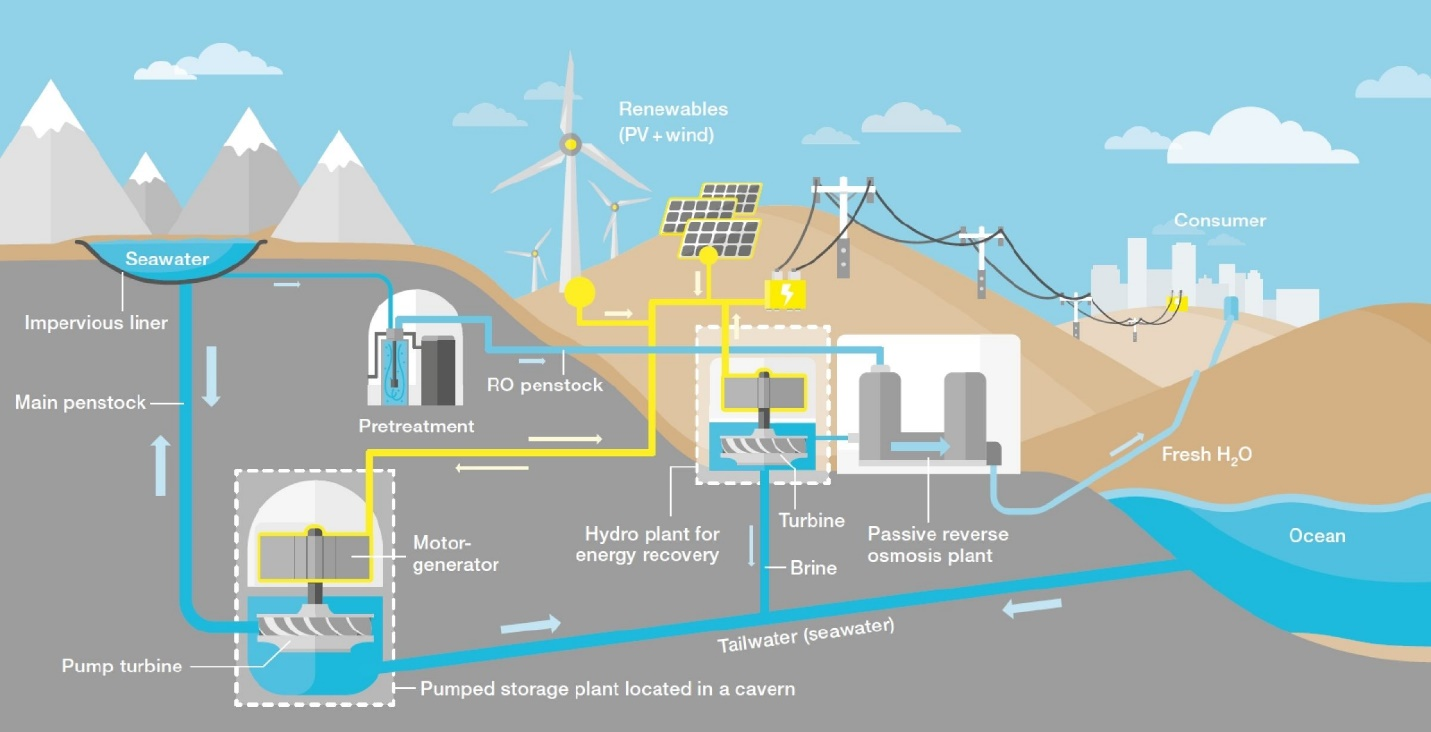
Buy Equipment or Ask for a Service
By using Linquip RFQ Service, you can expect to receive quotations from various suppliers across multiple industries and regions.
Click Here to Request a Quotation From Suppliers and Service Providers
Read More on Linquip

